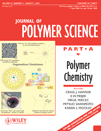Synthesis and magnetic properties of comb-like copolymeric complexes based on thiazole ring and ionic liquid
Abstract
Two comb-like copolymers (BIMT and PMB) composed of N-2-thiazolylmethacrylamide (NTMA) and 2-(1-butylimidazolium-3-yl) ethyl methacrylate tetrafluoroborate (BIMA) were prepared by free radical polymerization and reversible addition-fragmentation chain transfer (RAFT) polymerization. The conversion of the monomers to copolymer has been confirmed by FTIR spectra and 1H NMR spectra. The metal (Ni2+, Nd3+) complexes of these two copolymers were prepared, and the magnetic behaviors of the complexes were studied. The coordinated complexes display three possible chelating structures, which lie on the nitrogen donor and oxygen donor ligands and the kinds of the metal ions. The bimetallic complexes (BIMT-Nd-Ni and PMB-Nd-Ni) were synthesized by using the different coordination sites of the polymers. The magnetic properties of the complexes show that different structures arising from the different preparations, the kinds and the contents of metal ions, and the state of the complexes can infect the exchange interaction between the metal ions and induce various magnetic phenomena. © 2008 Wiley Periodicals, Inc. J Polym Sci Part A: Polym Chem 46: 5123–5132, 2008




